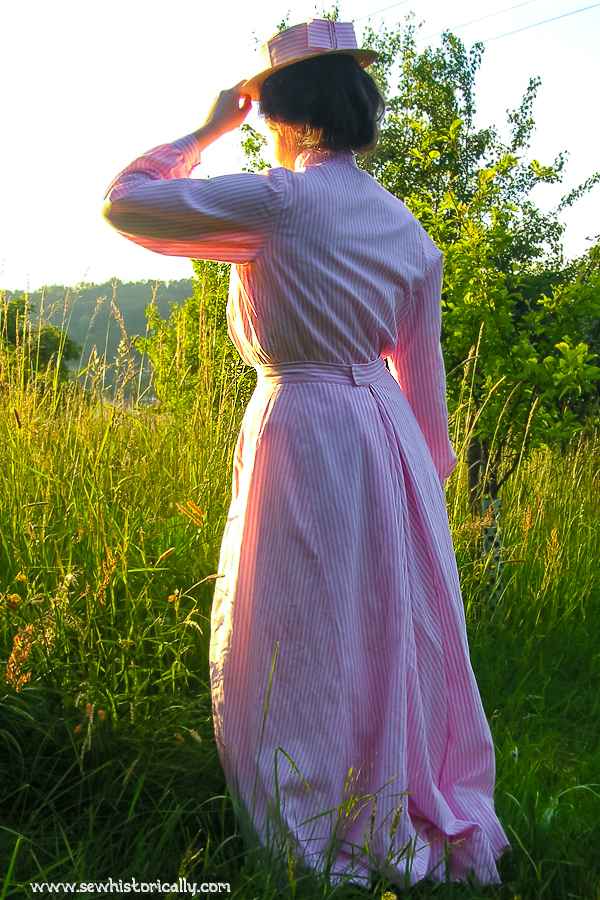The skirt of my Edwardian pink gingham maid dress is separate from the shirtwaist which is typical of Edwardian dresses. The skirt is based on this free antique Edwardian sewing pattern: the 1901 skirt Astarte (without the flounce).
Related: Edwardian Pink Gingham Maid Dress
The shape and measurements of my skirt are similar to the skirt Astarte. But I made a gored skirt instead which is better for a cotton wash dress according to the following Edwardian source.
A gored skirt ‘is better better than a circular skirt, because the bias sides of that stretch and pull badly’ (McCalls, 1908).
The skirt consists of five pieces. At each seam a straight-cut edge always meets a bias-cut edge – apart from the back seam where two bias-cut edges meet – like on this 1905 striped cotton wash dress.
My skirt has an inverted box pleat at the center back which almost all Edwardian dresses had. And it closes with two hooks & eyes and three snaps on the continuous bound placket under the inverted box pleat at the center back.
Related: 6 Ways How To Sew A Placket – Historical Sewing Tutorial
A skirt is ‘usually held together with hooks and eyes, or snaps’ (School Sewing Based On Home Problems, 1916).
I overcast all inside seams by hand like these 1916 sewing instructions for a gingham house dress recommend.
Related: 34 Types of Seams – Historical Sewing
An overcast seam is used ‘where it is desirable to have the seam show as little as possible’ (School Sewing Based On Home Problems, 1916).
In the Edwardian era, wash dresses – also called tub frocks – were usually shorter than other dresses. ‘Short’ means ‘ankle-length’ in the 1900s 😉 which is pretty short compared to most Edwardian skirts that were much longer than floor lengths in front and usually had a long train at the back.
Related: 1900-1909 Edwardian Fashion Timeline
‘All tub frocks should be short’ (Every Woman’s Encyclopaedia, 1910-2a), ‘ankle length is permissible and very smart’ (Every Woman’s Encyclopaedia, 1910-2b).
So I also made my Edwardian pink striped gingham skirt ankle-length which is much shorter than the wool skirt of my Edwardian shirtwaist costume for example. By the way, the high grass is misleading: 😉 the skirt doesn’t touch the ground all ways around.
Related: Edwardian Shirtwaist Costume
My wash dress skirt has a deep hem similar to this antique pink striped cotton dress. Most Edwardian cotton wash dresses had deep hems to add weight so that the skirt hangs better.
I also often wear this Edwardian cotton skirt with an Edwardian white cotton shirtwaist. Click on the link below for photos.

